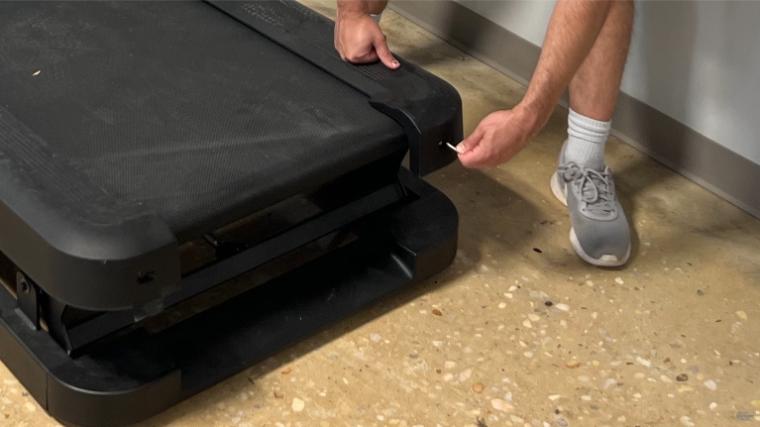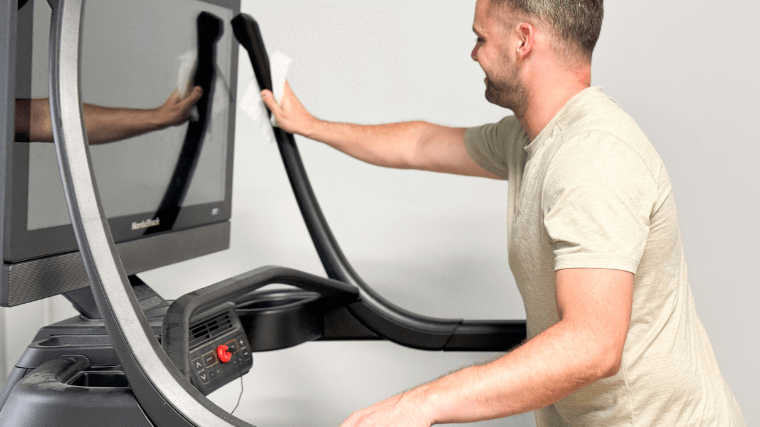Weird burning smells, error codes, strange noises, and workout interruptions aren’t something you want to deal with in the middle of your cardio. But let’s be real, fitness equipment is not immune to repairs — especially if you’ve been lax on preventative maintenance. Even on the best treadmills, issues can arise from a lack of belt lubricant, improper belt tension, or neglecting regular treadmill maintenance. And with so many moving parts, it might take some troubleshooting to pinpoint an answer.
In some cases, you can break out the trusty owner’s manual and complete some basic treadmill maintenance. Other scenarios might require a little more effort or a call to the treadmill doctor. Still trying to figure out where to start? Right here! We’re breaking down some common repair issues in treadmills and giving some tips for getting your home treadmill repaired.
Common Treadmill Problems
If you suspect something’s brewing with your treadmill’s performance, it can be tempting to take the “let it ride and see what happens” approach. I can assure you this is not the route you want to go, as it can cause further damage or potentially put you in danger.

I tried this approach when I was sixteen with my vehicle and it did not end well — and believe it or not, the mechanics of gym equipment like treadmills and ellipticals are in some ways similar to those in an automobile. Fortunately, if you perform regular maintenance on your treadmill (like you should do on a vehicle), most treadmills stay in great condition for many years.
[Related: Best High-End Treadmills]
Slipping Belt
A jerky, hesitating, or uneven belt is referred to as a slipping treadmill belt. Not only can this interrupt your workout, but it can also be dangerous. If this is an issue with your treadmill belt, here are some common causes.
- Insufficient Tension: The running belt is too loose.
- Worn Belt or Deck: The belt or the deck (the surface under the belt) can wear out over time.
- Improper Lubrication: The running belt is either too dry or overly lubricated.
- Motor Drive Belt Issues: The belt that connects the motor to the front roller might be loose or worn out.
- Alignment Issues: The running belt is not properly aligned.
- Roller Problems: Problems with the front or rear rollers can cause slippage.
Speed Issues
If your fitness equipment is not up to speed — literally — here are some common culprits of speed issues.
- Belt: The first (and easiest) thing to do is check the belt tension, lubrication, and signs of wear on the belt. A misaligned walking belt or improper tension can affect the speed and performance of your exercise equipment. Knowing how to adjust a treadmill belt may be a learning curve at your first go, but it is relatively easy after you’ve done it once.
- Motor: If it’s not the treadmill belt, it could be an issue with your motor, which will lead to inconsistent speeds.“Treadmills are generally tech-heavy, complex machines,” explains BarBend expert reviewer Amanda Capritto. If you suspect it’s the motor, check your user manual for troubleshooting tips but given the complexity of its mechanical parts, it may need professional repair.
- Dirty or Misaligned Speed Sensor: Locate the speed sensor, usually near the motor or the belt, and clean it. Ensure it is properly aligned with the speed sensor magnet on the flywheel.
- Power Supply: If the motor is not the issue (fingers crossed), it could also be a power supply problem. Check your power cord to make sure it’s working properly. It’s generally advised to plug your treadmill into a dedicated circuit and avoid power strips and extension cords in your home gym.
- Software Glitch: When you’ve exhausted all other options, a treadmill reset might be needed. Keep in mind that resetting a treadmill to its factory settings will erase your personal settings. High-tech exercise equipment might need a reboot, like a computer, to get things back in order.
Malfunctioning Console
The treadmill console serves as the control panel and user interface. Issues with the console can manifest as unresponsive buttons, a blank or flickering display, freezing, error codes, or inaccurate readings.

Below are some troubleshooting tips for a malfunctioning console.
- Power Cycle: Turn off your fitness equipment, unplug it, wait a few minutes, then plug it back in and turn it on.
- Check for Firmware Updates: Look on the manufacturer’s website for any firmware updates and follow their update process.
- Inspect Cables and Connections: Ensure all cables are securely connected and undamaged.
- Reset the Console: Follow the instructions in your user manual to reset the console to factory settings.
Error Codes
In some cases, you won’t have to guess if something funky is up with your treadmill thanks to error codes. Even on the best budget treadmills, an error code should appear on the screen of your console to indicate when there’s an issue or malfunction.
While many treadmills share the same error codes, the best place for you to find the meaning of your treadmill’s error code is on the manufacturer’s website or in the owner’s manual, as they can vary from specific brands and models.
Burning Smell
What’s that smell? is not something you want to hear or think to yourself when you’re in the middle of your run. But if you do, get off and shut your fitness equipment down immediately.
A burning smell can be an indication of several things and isn’t something to be taken lightly. See some common causes below.
- Overheating motor
- Friction between the belt and deck
- Dust, dirt, hair, build-up, or debris in the motor — see our tips on how to clean treadmills
- Electrical issues
- Exceeding the weight limit
DIY Treadmill Repair
Repair costs, replacement parts, and service calls for your treadmill problems can run steep, so check out these DIY maintenance tips before you schedule an appointment with the treadmill doctor.
Check Power Cord and Batteries
The best place to start your DIY endeavor is to check your power source. Ensure your power cord is in good condition and plugged directly into an outlet. If you’re using an extension cord or power strip, check the condition of those as well.
For treadmills that use batteries for the motor or console, make sure they are in working order.
Adjust the Running Belt
A common cause of treadmill issues is a walking belt that’s too loose, too tight, or misaligned.

Having the right belt tension and alignment prevents belt slipping, hesitation, wear and tear, and provides a safer, more enjoyable workout.
Lubricate the Running Belt
If you don’t know how to lubricate a treadmill belt and you’re a treadmill owner, it’s time to learn. It’s vital in extending the lifespan of your walking belt and the fitness equipment itself. A quick application of silicone lube can drastically improve the quality of your workout and is a must in preventative maintenance.
When to Opt for Professional Repair
The complexity of a treadmill’s mechanical, electrical, and technological components can create problems that the average treadmill owner may not be able to resolve on their own. If your treadmill problems are bigger than you can handle, it’s time to recruit professional repair help.
Professional repair and replacement parts can be pricey, so be sure to shop around and get quotes from multiple technicians. The service call alone — without the repair — can run anywhere from $50-$150 depending on where you live. Look for a certified technician with good reviews.
If you purchased a high-quality treadmill like a NordicTrack or ProForm, be sure to check your warranty, as many common issues are covered with reputable brands. Below are some scenarios where you may want to consider a pro.
Faulty Treadmill Motor
Treadmill motors are made up of windings, rotors, brushes, commutators, bearings, shafts, and a whole lot of other components that are likely foreign to the average treadmill owner. If you know or suspect that there’s an issue with your treadmill motor, and you’ve exhausted troubleshooting tips, it’s probably worth seeking professional help.
Depending on the issue, your make and model, and what parts are needed, you can anticipate spending between $100 and $600 on a treadmill motor repair. (For commercial models, a motor repair can cost significantly more.)
Electrical Issues
One look at your treadmill’s motor control board and you’ll probably agree that you don’t want any part of that. Not only are wires, circuit boards, and volts intimidating, but they can also be dangerous if you don’t know what you’re doing.
Persistent Burning Smell
If there is a persistent burning smell coming from your treadmill, and you’ve ruled out something minor like hair or dirt in the motor, it’s usually best to hire a professional to pin down the cause.
Ignoring the smell can cause further damage and depending on what it is, it could potentially be a fire hazard. No one wants to stop, drop, and roll mid-workout.
Preventive Maintenance
Small maintenance tasks can make a big difference in your exercise equipment’s lifespan, performance, long-term costs, and safety. It’s also necessary to keep your warranty valid.

Implementing a preventative maintenance schedule can ensure that your fitness equipment is in good working condition and reduce your overall cost of ownership.
| Daily/Weekly | * Wipe down handrails, frame, console, and other high-touch surfaces * Vacuum the treadmill mat, and around and underneath the treadmill |
| Bi-Monthly | * Inspect the walking belt for wear and tear * Check the walking belt’s tension and alignment * Clean the motor area of dirt, hair, and debris * Lube the belt and deck with silicone lubricant |
| Annual | * Inspect the rollers, bearings, and hardware * Inspect the power cord, plug, and electrical components *Optional professional inspection |
[Related: How to Clean a Treadmill Belt]
Final Word
Seeing an error code, encountering a burning smell, or noticing your treadmill is a little wonky can be frustrating but shouldn’t be overlooked or pushed to the back burner. Many common issues with treadmills can be resolved with relatively easy DIY maintenance. Keeping up with your preventative maintenance will keep most major issues at bay and prolong the lifespan of your fitness equipment.
If your treadmill has issues requiring professional help, receive multiple quotes and inquire if the technician has experience with your particular model. Lastly, determine if the cost of the repair is justified for the age and condition of your equipment.
Treadmill Repair FAQs
What is the common problem with a treadmill?
Issues with the treadmill belt are the most common, particularly belt slippage. Improper tension, misalignment, too little or too much lubrication, wear and tear, and a faulty drive belt can all contribute to belt slippage. You can prevent belt slippage by regularly inspecting the tension and alignment, as well as by cleaning and properly lubricating it.
Is it better to repair a treadmill or buy a new one?
Many issues can be resolved on your own with simple maintenance tasks. For major issues, add up all costs to repair — parts, labor, and service calls. Then determine if the cost is justified based on the current age and condition of your treadmill. A good rule of thumb is if the cost of repairs is more than 50% of the treadmill’s current value, consider replacing it.
Are treadmills expensive to repair?
Minor issues can usually be repaired or fixed for the cost of a service call or the cost of the treadmill parts if you do it yourself. Issues with the motor, electrical components, and technology are generally a much higher repair cost than replacing a belt or mechanical parts.